May 24, 2018
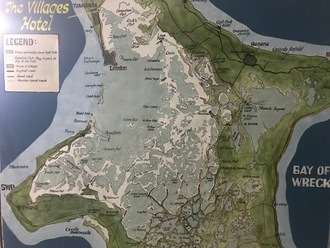 Christmas Island, situated deep in the Pacific Ocean, was undoubtedly a success story for me. This was my first warm water fly fishing trip, and all I can say is the warm 80 degree water and consistently warm weather was a nice change from the Seattle, Washington weather I am used to. We were greeted at the airport by the happy staff at the Villages, where we were staying. They even had cold beer for us to drink on the way to the lodge. We loaded our gear into the trucks and headed off to the Villages resort about 20 minutes down the road.
Christmas Island, situated deep in the Pacific Ocean, was undoubtedly a success story for me. This was my first warm water fly fishing trip, and all I can say is the warm 80 degree water and consistently warm weather was a nice change from the Seattle, Washington weather I am used to. We were greeted at the airport by the happy staff at the Villages, where we were staying. They even had cold beer for us to drink on the way to the lodge. We loaded our gear into the trucks and headed off to the Villages resort about 20 minutes down the road.
Warm saltwater – what the heck is that? I grew up in the Seattle area and have fished saltwater my whole life. Cold saltwater, as many of you know will turn your feet blue within 10 minutes, and wet wading isn’t much of an option even in the summer when it is 90 degrees out. This water however, was unbelievably warm – even quite a bit warmer than the Hawaiian water I swam in a few days prior. I guess that what happens when you are close to the equator.
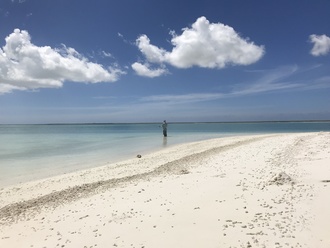
My trip planning started a year prior with gear prep, research and a crazy amount of time on the internet learning about where I was traveling too. Red’s fly shop provides a great resource to learn about this trip. Check out this article preparing for a Christmas Island trip written by Joe Rotter. It is very informative and gives a the low down on what an angler will need to venture out on this adventure. I gotta say, it was pretty dang accurate and I wasn’t without anything I needed.
Rods: I brought an 8, 10 and 12 weight rod. I went high end with a Sage Salt 890 HD for my bonefish rod cause I knew I would be using it the most. It paid off having a precise, fast action rod to make quick casts with for fish on the move and I didn’t wear my arm out. I primarily used the 8 weight, and the guide carried the 12 weight in case a GT came swimming by. I went with the Redington Predator 10 and 12 weights for my larger rods. The 1090 Predator casts really nice, but I didn’t use this much cause the guides liked to only carry one extra rod. The 12 weight was my GT rod, and a beast to cast, primarily because you are throwing a 6 inch streamer on the end of it. If you plan to specifically target Giant Trevally all day go with a high end rod. Practice lots with your 12 weight in the backyard prior to going These rods worked great, but i think I would bring an 8 and an 11 weight next time. The 8 weight as my bonefish hunting tool, and the 11 weight I would use for Giant Trevally, Blue Fin Trevally and any other species that would take a whack at it. Its lighter and a tad easier to cast, especially if you plan to pursue GTs daily. Our host, Eric Dalzell had a nice Winston 11 weight that cast significantly better than my 12 weight Predator.
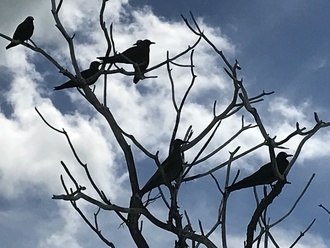
Reels – Buy good reels with sealed drags. Since I am Northwest saltwater guy, I rarely buy high end reels with sealed drag systems because I rarely, if at all, submerge my reels. In the rare instance I do I take them apart, rinse them and oil them up and they last well. However, on this trip I was wet wading from mid-calf all the way to chest deep and my reels were routinely submerged. One spot we fished, called the Gymnasium off the the town of London, was a blind casting spot for bone fish. This is a spot the guides like to go when it is cloudy out and we are unable to spot and stalk. I happen to hit the day right, and there was a large school of bones turning up the bottom. It was literally a fish on every cast for 90 minutes straight. We followed the school of bones into deeper water until I was over my chest. The rod and reel were under water as I was stripping line in and when I hooked a fish the rod came out of the water and the reel buzzed like a water wheel as line peeled out. It was incredible and I think I wore my guide out. I wanted to keep fishing and was almost swimming to chase these bone fish. My reel on my bone fish rod is one of the newer Redington Rise reels it worked great with a smooth drag. My other two reels on my 10 and 12 weight rods were the Redington Behemoth. These are sweet reels with a good drag system, however after inspection the day after I got home the internal components are already starting to corrode from being submerged. Spending a lot of money for reels is a tough decision, but it will last you a life time versus having to replace them.
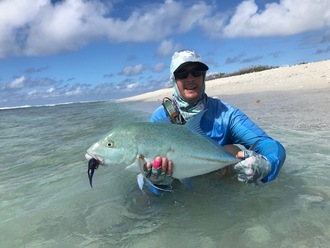
Sling pack or Backpack – buy good quality here also. While chasing those bonefish above, I had my Fishpond Sling pack sealed tight. It was literally floating on the water behind me. The guide put his cell phone in there prior to going deep after the bones. Any pack with the Ti-ZIp zipper feature is what you want. This kept everything dry day after day of it being in the water. The FishPond sling pack was also very easy to access with minimal work. If you are using a backpack, you have to take it off to access your gear which makes for a less efficient and more time consuming fly change.
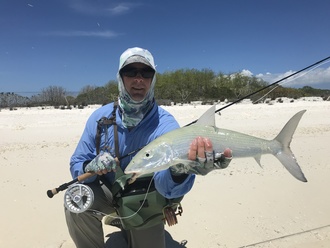
The Guides – Each day we were greeted by our friendly guides. This s a 1 to 1 guide to angler ratio which makes it very nice for first time or returning anglers. The experience level of the guides ranges from 20+ year guides to guides who are within their first few years. Each of my guides was friendly, and every day I had a new guide. There is somewhat of a language barrier, so spending a few minutes at the beginning of each day discussing how the guide will point to a fish and describe distance and direction the fish was traveling paid dividends throughout the day. Some guides estimation of 20 feet, was more like 40 feet to me. However, what I learned was a lot of times the fish was 40 feet away, but the guide wanted you to cast 20 feet away cause the fish was moving toward us. Those are the little communication things to work out at the beginning of each day. As Joe says, by nature the guides don’t talk a lot, so yo have to prime them for information at times.
Spot and stalk bone fishing and the flats and near shore edges proved to be my favorite type of fishing. This is very active and engaging fishing. If the trevally showed up, my guide would toss me the 12 weight really quick and take my 8 weight for some shots. Some anglers fished hard all day for GTs and some were successful. I preferred bone fishing primarily with the GT option if they showed.
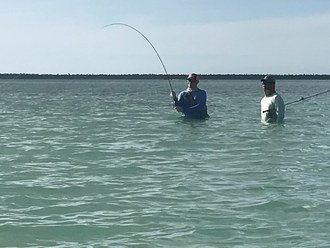
Giant Trevally – We fished 6 days, and the first day I got a shot at 60+ pound GT who was terrorizing the flats looking for a meal. My guided tossed me my 12 weight and yelled Trevally. The GT was cruising fast, so he kicked his legs in the water and threw a large boulder towards it creating a disturbance that sounded like a baitfish commotion. The GT turned and a laid my line down with a large splash from my fly about 10 feet away. The GT pursued my fly like a shark on the hunt and I thought I had him until he turned away at the last minute. That was an adrenaline rush for sure.
The Korean Wreck – This was one of my favorite adventures. The day started a touch earlier here as we met out guides for a 5:45 departure due to the truck ride of an hour and a half. At the wreck, we were fishing the ocean side of Christmas Island. Essentially we were fishing somewhat calmer water inside the reef breaks from the ocean. GTs, Blue Fin Trevallys, Lady Fish and various other species inhabit these waters. It was a nice change of pace fishing this area compared to the lagoon. There are couple World War 2 era airfields we go by while fishing this area. We also traveled through one of the islands frigate bird nesting areas. The birds don’t have any predators to worry about on the island so they literally lay their eggs on the sand, road and under bushes. It was quite unique, and it gave me more of a perspective of the life and culture of the island as we traveled through various villages, and got to see some of locals subsistence fishing and free diving for tropical fish. I hooked and landed my largest Blue Fin Trevally here.
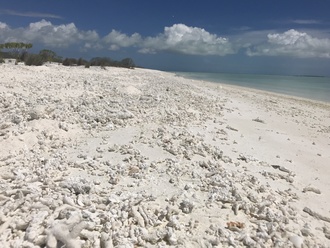
The Food – This was a big deal for me cause I like to eat. The food was great. Breakfast started each morning around 5:15 and consisted of eggs, omelet and some bacon. The staff was always well prepared, and I think I over ate each day. Lunch was provided and you fixed your own sandwich each day and a piece of fruit. Four bottles of water was provided each day for each angler on the boat. Dinner was typically way more than I could eat and was a mix of island food – tuna, pork and beef. There was also some sashimi as an appetizer prior to dinner. This was fresh caught eat day by the blue water boats.
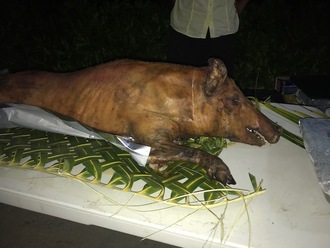
Accommodations – It was 2 anglers per room. There was plenty of room here, with a bathroom, refrigerator and two twin beds. The hotel staff cleaned our room each day and I gotta say it was very nice coming back to a freshened up room. Laundry is 20 bucks per week, per person. So, you can literally have your laundry done and folded for you on your return from fishing. I brought was too many clothes and next time I will condense it down to half of what I brought and just get them washed daily.
The Cats – there are these wild feral cats that inhabit the island and we were lucky enough to have the only room where they had homes in the attic space. Routinely, we had cat fights going on in the attic and heard scratching and cats running around up there. It gave my room mate and I something to laugh about. Apparently Room 4, where we stayed, had the same cats last year in it.
This trip was great! Definitely a bucket list trip for anglers looking for a total warm saltwater fly fishing experience with shots at various species. The Villages Lodge is a well oiled machine and caters well to anglers and brings intertwines their own island culture into your trip. Put it on your list for 2019!
Book your trip with Reds Fly Shop and Capt. Chad – Sept. 10-17, 2019 I will be hosting a trip to Christmas Island!
